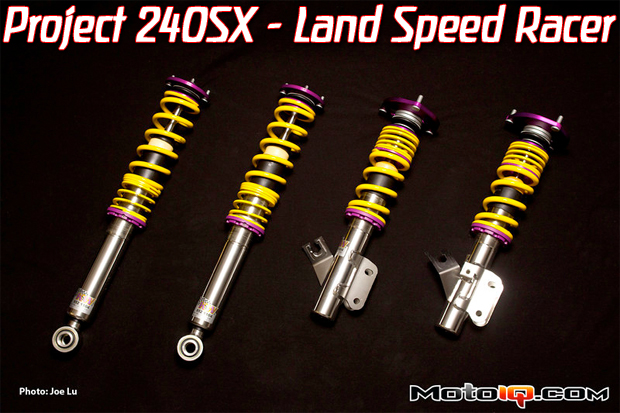,
On our KW dampers, the compression and rebound damping can be quickly and easily adjusted independently with adjustments located on each end of the damper. The rebound adjustment is located at the end of the induction hardened, chromed piston rod allowing for it to be easily accessed from under the hood.
 If you are wondering how the valving and adjusting knobs of a KW twin tube works, here it is. The low speed rebound damping is controlled mostly by the piston on the end of the shock rod. Turning the rebound adjusting knob located on the top of the shaft screws the tapered metering rod “V” up and down varying the size of the orifice. The low speed fluid flow is represented by the green arrows. At higher shaft speeds the mid and high speed circuit kicks in, the high speed fluid flow is shown by the blue arrows. The hydraulic pressure deflects the metering disc shown in yellow for mid speed damping and higher velocities allow the spring loaded blow off of the disc to open.
If you are wondering how the valving and adjusting knobs of a KW twin tube works, here it is. The low speed rebound damping is controlled mostly by the piston on the end of the shock rod. Turning the rebound adjusting knob located on the top of the shaft screws the tapered metering rod “V” up and down varying the size of the orifice. The low speed fluid flow is represented by the green arrows. At higher shaft speeds the mid and high speed circuit kicks in, the high speed fluid flow is shown by the blue arrows. The hydraulic pressure deflects the metering disc shown in yellow for mid speed damping and higher velocities allow the spring loaded blow off of the disc to open.
Compression adjustments can be accessed through a slot near the lower mounting eye of the rear dampers or via an allen bolt located on the bottom side of the damper, in the front.
 In rebound, the shock's foot valve located on the bottom of the shock, simply acts like a one way check valve allowing fluid displaced by the shock shaft to flow into the outer tube and the hydraulic accumulator.
In rebound, the shock's foot valve located on the bottom of the shock, simply acts like a one way check valve allowing fluid displaced by the shock shaft to flow into the outer tube and the hydraulic accumulator.
Rebound damping is responsible for controlling the reaction of the vehicle's sprung mass on the vehicle's unsprung mass. Without adequate rebound damping, the force generated from an uncompressing spring extends the suspension outward (potentially to full droop). This will cause the tire to push against the ground and in turn lift up that corner of the vehicle. If not properly damped, this can cause a cycle of oscillations that reduce tire contact with the ground and result in poor stability at high speeds. On the other hand, too much rebound dampening can also preload the suspension, effectively stiffening it, reducing traction. This will make it necessary for us to play around with the settings to find a good balance once the car is running.
 In compression most of the damping control is handled by the foot valve so the valving in the piston mostly acts like a one way check valve with some damping control across the board at all speeds.
In compression most of the damping control is handled by the foot valve so the valving in the piston mostly acts like a one way check valve with some damping control across the board at all speeds.
The rebound adjustment primarily affects the low speed damping–shock piston velocities in the 0-2″ per second range. Low speed damping adjustment affects body motions such as roll and pitch. This is in the area which the driver feels the most when driving fast. In our shocks, the main shaft and piston ride in the inner tube of the shock body with the rebound damping adjuster built into the low speed circuit of the piston. A threaded tapered rod that goes to a knob at the top of the shaft controls the size of the low speed damping orifice. The knob is adjusted with an allen wrench. Screwing it in and out raises and lowers the tapered end of the rod into the orifice which changes the amount of fluid that can flow through it. When the orifice is mostly blocked by the taper, little oil can flow and there is a lot of low speed damping. When the orifice is open, the fluid can flow freely and the damping is decreased. The piston also has a unique two stage system combining a deflected disc valve system and a spring loaded blow off valve for controlling the rest of the velocity range.
KW's patented foot valve lives on the bottom of the inner tube and regulates the flow of fluid between the inner and outer tubes. This is where compression damping is controlled. KW's patented valve controls compression damping at low piston rods speeds such as the gradual load transfer to the outside suspension during a turn. However, at high speeds piston rod speeds for example, a large sharp edged bump or pothole, the KW damper uses a “blow off” feature in the form of a bypass duct. This bypass feature allows spring to absorb the sudden “shock” of high piston rod speeds. (It's actually the springs job to absorb shock, not the damper or “shock absorber.”) Without this blow off feature, the damper may not allow the suspension to respond fast enough causing the wheel to judder, adversely affecting tire compliance with the road.
The compression damping adjuster is a spring loaded needle valve that controls the size of the low speed compression damping orifice located in the foot valve as well as the valve spring preload. The needle valve is adjusted via an allen screw on the bottom of the shock body. Like the rebound, the compression adjuster also mostly influences low speed compression damping, which like rebound is the part of the damping curve that influences body motion.



